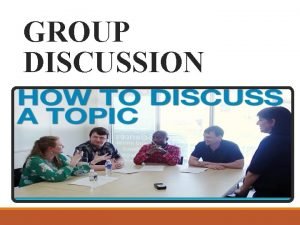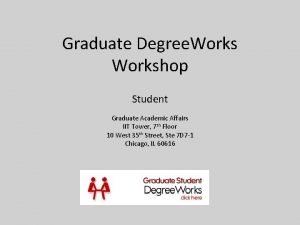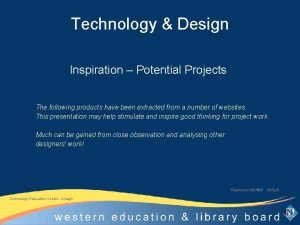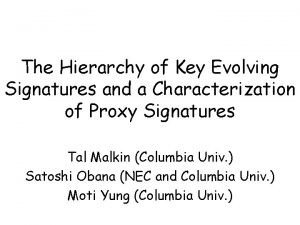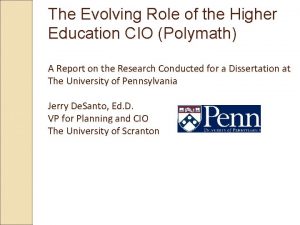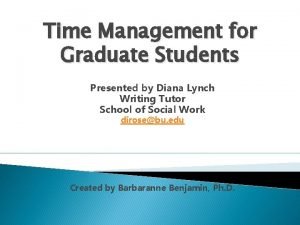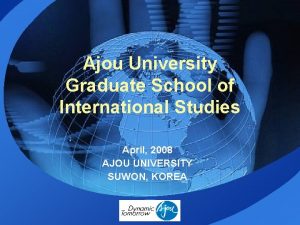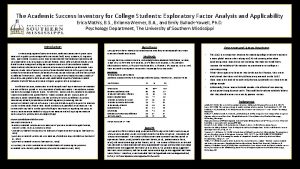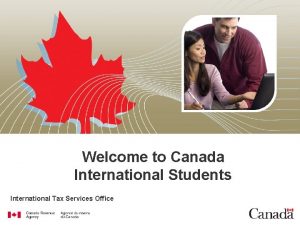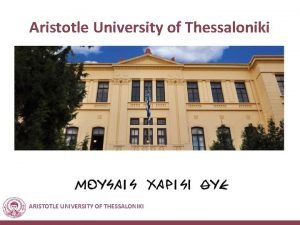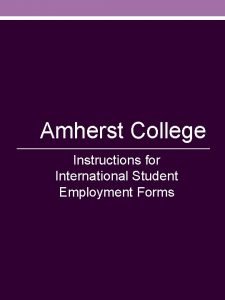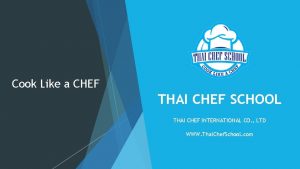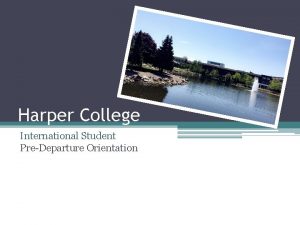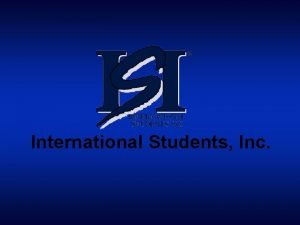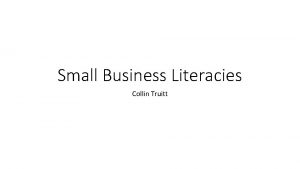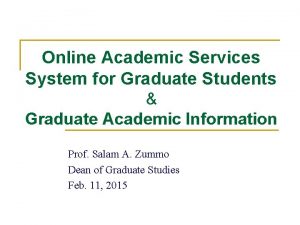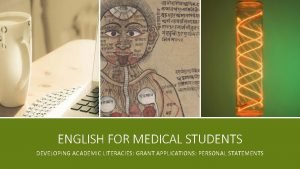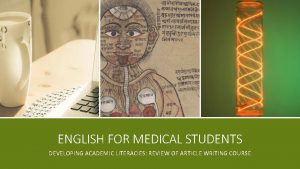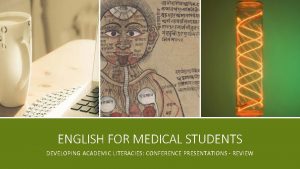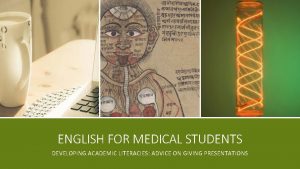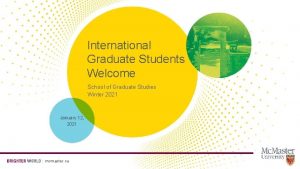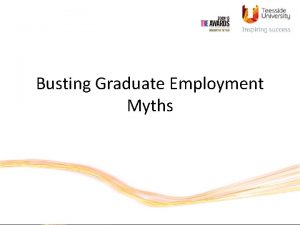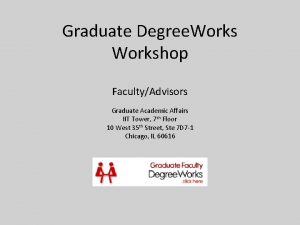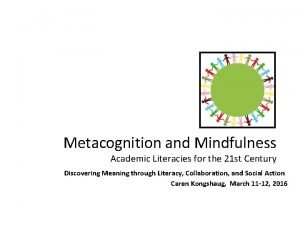Assessing International Graduate Students Evolving Academic Literacies Master
















- Slides: 16

Assessing International Graduate Students Evolving Academic Literacies: Master of Engineering Learning Outcomes – Evolution of Assessment Conference Council of Ontario Universities Double. Tree by Hilton Hotel Toronto Downtown 17 th-18 th October 2016 Stephen C. Armstrong

III The Recognized Engineer Gaps – “Soft Skills” Learning Outcomes Presentation Copyright AMGI 2016 Page 2

III The Recognized Gaps – Critical Thinking Learning Outcomes Presentation Copyright AMGI 2016 Page 3

UNIVERSITY OF TORONTO- Master of Engineering (MEng) MEng - Professional Degree Stream… Ø MEng- 20% of all graduate students Ø MASc - 22% Ø Ph. D – 58% Ø 9 or 10 courses, or combine fewer courses with a project. Ø Full-time in a year, or Extended Fulltime in two years. Learning Outcomes Presentation Copyright AMGI 2016 Page 4

VII MEng Applications 2015/2016 (2, 000 applicants) – 800 Domestic and 1, 200 International 1000 Domestic 800 International 600 400 2005 -06 06 -07 Learning Outcomes Presentation Copyright AMGI 2016 07 -08 08 -09 09 -10 10 -11 11 -12 12 -13 13 -14 14 -15 Page 5

VII MEng Enrolment 2015/2016 – 299 International and 516 Domestic 800 700 600 500 400 300 200 100 0 2005 -06 06 -07 07 -08 Learning Outcomes Presentation Copyright AMGI 2016 08 -09 09 -10 10 -11 11 -12 12 -13 13 -14 14 -15 Page 6

VII MEng Certificates/Specializations Learning Outcomes Presentation Copyright AMGI 2016 Page 7

ELITE Certificate E - Entrepreneurship L - Leadership I - Innovation T - Technology E - Engineering Learning Outcomes Presentation Copyright AMGI 2016 Page 8

VII ELITE Certificates Awarded In 2015/2016 - 125 120 100 80 60 40 2008 -09 09 -10 Learning Outcomes Presentation Copyright AMGI 2016 10 -11 11 -12 12 -13 13 -14 14 -15 Page 9

APS 1012 Management of Innovation - Syllabus n Part I – Innovation in Context n n Ø Week 1 Mod 1 –Orientation, overview of syllabus, & planning assignments Ø Week 2 –Mod 2 - Dimensions of Innovation Ø Week 3 – Mod 3 - Diffusion of Innovation Part 2 – Developing an Innovative Enterprise Ø Week 4 –Mod 4 - Designing an Innovative Enterprise - Business Transformation Ø Week 5 - Mod 5 - Organizational Approach to Cultural Transformation Ø Week 6 –Mod 6 - Enterprise Integration and Process Management Part 3 – Building the Innovation Process Methodology Ø Week 7 – Mod 7 - Integrating Process, Project Management & IPTs Ø Week 8 –Mod 8 - Integrating Process, Project & Knowledge Management Ø Week 9 –Mod 9 - Deploying and embedding the innovation process Part 4 – Sustaining the Innovative Lean Enterprise Ø Week 10 – Mod 10 - Continuous Analyses of the “As Is” / “To Be” Business Process Ø Week 11 – Mod 11 - Continuous Improvement through creativity & problem solving Ø Week 12 – Mod 12 - Engaging the people and maintaining an innovative culture Part 5 - Final Team Innovation Projects Learning Outcomes Presentation Copyright AMGI 2016 Page 10

APS 1012 - Learning Outcomes n Establish a context for Innovation and its dimensions n Analyze the elements of Innovation management as a key organizational capability n Explain how innovations are diffused across cultures n Identify how to develop an innovative future state vision through systems thinking n Develop and prepare an organization for an innovation transformation initiative n Explain and assess a culture of innovation for readiness to change n Identify how to overcome the barriers to innovation in organizations n Develop the key leadership roles in managing innovation at the group/department, division, and corporate levels n Develop an integrated enterprise approach to innovation n Design an Innovation delivery system for various environments n Apply process management and project management practices to product development n Organize and develop integrated Project / Product teams (IPT’s) for project execution n Deploy and Embed an innovation process through the core culture n Continuously assess the “As Is” business processes n Continuously improve the “As Is” process through structured problem solving n Apply the key strategies to engage the people to sustain an innovative culture n Identify challenges in measuring and maintaining innovation performance Learning Outcomes Presentation Copyright AMGI 2016 Page 11

APS 1012 -Assessment Approach-Online Version n Inclass Presentations – 4 Off based on module content discussion board questions – 30% OR…. . n Discussion Board Contribution (10 out off 12) – provides breadth in knowledge 30% n Mid Term Critical Review (CR 1) Paper (based on discussions Mods 1 -6) 15% n One 4 -6 minute video that critiques your mid term CR using the Rubric 10% n Final Critical Review (CR 2) Paper (based on discussions in Mods 7 -12) 15% n Project Team Report– (Charter - 5%) (PPT Summary – 5%) 30% Learning Outcomes Presentation Copyright AMGI 2016 Page 12

APS 1012 Course Mechanics n Extensive use of online learning tools (Blackboard) – 60 plus Videos across all modules n 12 Modules coordinated to open each week n Students watch lectures before class n Discussion board engagement n Written critical reviews n Assessment Rubric for presentation and written work n Activity based learning in class – students deliver response to questions in lecture n Inclass student response. Learning Outcomes Presentation Copyright AMGI 2016 Page 13

APS 1012 - Assessment Approach for IFP Simplified the Deliverables for IFP. . n 3 written Critical Review (CR) papers (650 -1000) words based on a primer or academic paper readings and a special interest topic 30% n Individual in-class presentations (4 off) based on module questions (video and reading) 40% n Final Project Team Report – (Charter – 5% & PPT Summary 5%) 30% n Assessment rubrics – discussions, project reports, presentations, critical reviews Learning Outcomes Presentation Copyright AMGI 2016 Page 14

Assessment Rubric – Discussion Board Learning Outcomes Presentation Copyright AMGI 2016 Page 15

APS 1012 -IFP Reflections – Lessons Learned n Class Size 16 -20 n All My courses simulate the real world of practice n Week 2 – Students complain that I am not lecturing enough – not oriented for real world practice – I resist n Foreign Language students Kick in around week 7 of the 12 week course- steep learning curve – they thank me for not lecturing in the class - amazing n Practice practice – presenting, discussing, preparing, teamwork engagement, CR writing n Teamwork during the week with and in class – constant feedback with IFP language profs – works well n Mainly Chinese students –used to sage on the stage - first time in the West - need to instill humor in the class Learning Outcomes Presentation Copyright AMGI 2016 Page 16
 Group discussion images
Group discussion images Graduate academic affairs iit
Graduate academic affairs iit Evolving design
Evolving design A framework for clustering evolving data streams
A framework for clustering evolving data streams Key evolving signature
Key evolving signature Evolving
Evolving Time management in graduate school
Time management in graduate school Ajou university graduate school
Ajou university graduate school Erika mathis
Erika mathis What made rizal as champion of filipino students
What made rizal as champion of filipino students Welcome canada amount for international students
Welcome canada amount for international students Aristotle university of thessaloniki international students
Aristotle university of thessaloniki international students Umass amherst ssn
Umass amherst ssn Culinary school in thailand for international students
Culinary school in thailand for international students Harper college international students
Harper college international students 2 most important commandments
2 most important commandments Btec sport unit 3
Btec sport unit 3
